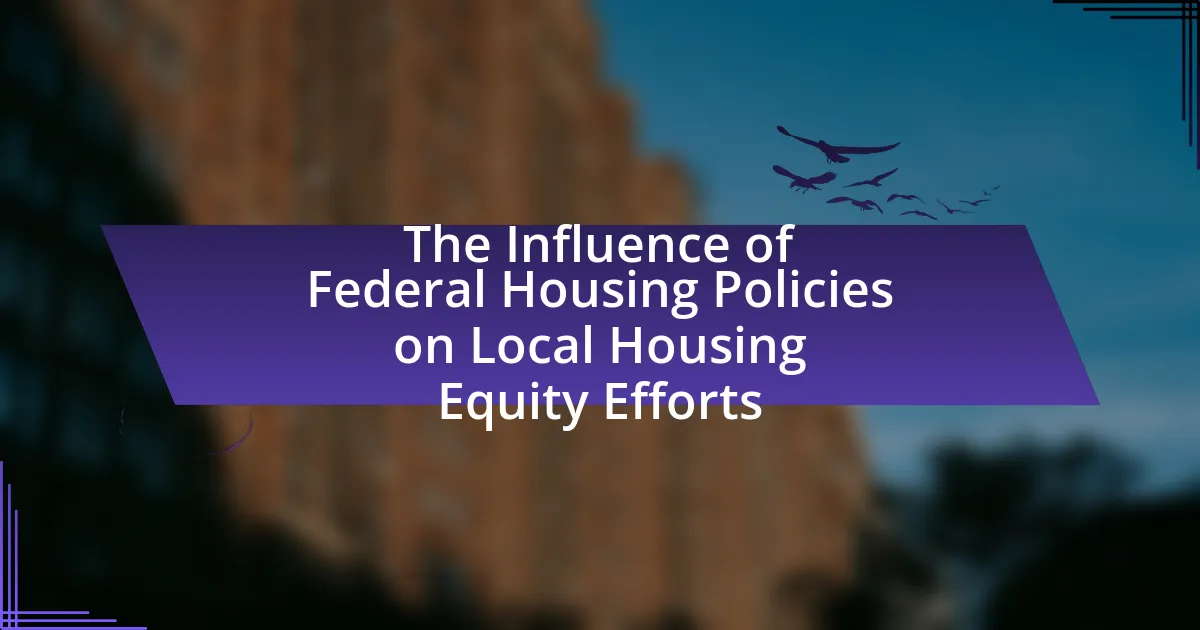Federal housing policies are regulations and initiatives established by the federal government aimed at influencing housing markets and ensuring equitable access to housing. This article examines the objectives of these policies, including promoting affordable housing, reducing homelessness, and ensuring fair housing practices. It explores how federal policies impact local housing markets, the specific policies implemented at the federal level, and their influence on housing supply and demand. Additionally, the article discusses the importance of housing equity efforts in local contexts, the challenges local governments face in aligning with federal policies, and the outcomes of these policies on local housing equity initiatives. Best practices for enhancing housing equity and strategies for effective advocacy by local governments are also highlighted.

What are Federal Housing Policies and Their Objectives?
Federal housing policies are regulations and initiatives established by the federal government to influence housing markets and ensure equitable access to housing. Their primary objectives include promoting affordable housing, reducing homelessness, ensuring fair housing practices, and supporting community development. For instance, the Fair Housing Act of 1968 aimed to eliminate discrimination in housing based on race, color, religion, sex, or national origin, thereby reinforcing the objective of equitable access to housing for all citizens. Additionally, programs like the Low-Income Housing Tax Credit (LIHTC) incentivize the development of affordable rental housing, directly addressing the need for affordable housing options in various communities.
How do Federal Housing Policies impact local housing markets?
Federal housing policies significantly impact local housing markets by shaping supply, demand, and affordability. For instance, policies such as the Federal Housing Administration’s mortgage insurance programs increase access to home financing, thereby stimulating demand in local markets. Additionally, zoning regulations influenced by federal guidelines can restrict or promote housing development, affecting the availability of affordable housing. Historical data shows that the introduction of the Community Reinvestment Act in 1977 led to increased lending in underserved areas, which improved local housing conditions and equity. Thus, federal policies directly influence local housing dynamics through financial accessibility and regulatory frameworks.
What specific policies have been implemented at the federal level?
The specific policies implemented at the federal level include the Fair Housing Act, which prohibits discrimination in housing based on race, color, religion, sex, national origin, familial status, and disability. Additionally, the Low-Income Housing Tax Credit program incentivizes the development of affordable rental housing. The Department of Housing and Urban Development (HUD) also administers various programs aimed at increasing access to affordable housing, such as the Housing Choice Voucher Program, which assists low-income families in renting homes in the private market. These policies collectively aim to promote housing equity and reduce disparities in access to housing across different demographics.
How do these policies influence housing supply and demand?
Federal housing policies significantly influence housing supply and demand by regulating market conditions and providing financial incentives. For instance, policies such as tax credits for affordable housing development encourage builders to increase supply, while zoning regulations can restrict or promote new construction, directly affecting availability. Additionally, demand is influenced through programs like mortgage assistance, which make homeownership more accessible, thereby increasing the number of potential buyers in the market. Historical data shows that the Low-Income Housing Tax Credit program has led to the creation of over 3 million affordable housing units since its inception in 1986, demonstrating a clear link between federal policy and housing supply.
Why are housing equity efforts important in local contexts?
Housing equity efforts are important in local contexts because they address systemic inequalities in access to affordable and quality housing. These efforts help to ensure that marginalized communities have equal opportunities for homeownership and stable living conditions, which are crucial for economic mobility and social stability. For instance, research from the Urban Institute indicates that neighborhoods with higher levels of housing equity experience lower rates of poverty and improved educational outcomes. By promoting equitable housing policies, local governments can mitigate the negative impacts of segregation and displacement, fostering inclusive communities that benefit all residents.
What is the definition of housing equity?
Housing equity is the difference between the market value of a property and the outstanding balance of any loans secured against it. This concept reflects the ownership stake that homeowners have in their property, which can increase as property values rise or as mortgage balances decrease. For instance, if a home is valued at $300,000 and the mortgage balance is $200,000, the homeowner has $100,000 in housing equity. This equity can be a significant financial resource for homeowners, influencing their ability to borrow against their property or sell it for profit.
How does housing equity affect community development?
Housing equity significantly enhances community development by promoting economic stability and social cohesion. When residents have equitable access to housing, they are more likely to invest in their neighborhoods, leading to improved local infrastructure and services. Studies indicate that communities with higher housing equity experience lower crime rates and better educational outcomes, as families can afford to live in areas with quality schools and resources. Furthermore, equitable housing policies can reduce displacement and gentrification, ensuring that long-term residents can remain in their communities, which fosters a sense of belonging and community engagement.

How do Federal Housing Policies Shape Local Housing Equity Efforts?
Federal housing policies significantly shape local housing equity efforts by establishing funding mechanisms, regulatory frameworks, and guidelines that influence local decision-making. For instance, the Community Development Block Grant (CDBG) program allocates federal funds to local governments, enabling them to address housing disparities and invest in affordable housing initiatives. Additionally, policies such as the Fair Housing Act mandate non-discriminatory practices, compelling local jurisdictions to implement equitable housing strategies. Research indicates that areas receiving federal assistance often see improved access to housing for marginalized communities, demonstrating the direct impact of federal policies on local equity outcomes.
What mechanisms connect federal policies to local housing initiatives?
Federal policies connect to local housing initiatives through funding programs, regulatory frameworks, and technical assistance. Funding programs, such as the Community Development Block Grant (CDBG) and Low-Income Housing Tax Credit (LIHTC), provide financial resources that local governments can use to develop affordable housing projects. Regulatory frameworks, including the Fair Housing Act, establish guidelines that local initiatives must follow to ensure compliance with federal standards. Additionally, technical assistance from federal agencies, such as the Department of Housing and Urban Development (HUD), offers support in planning and implementing local housing strategies. These mechanisms ensure that federal objectives align with local needs, promoting equitable housing development across communities.
How do funding and grants from federal programs influence local efforts?
Funding and grants from federal programs significantly enhance local efforts by providing essential financial resources that enable the implementation of housing equity initiatives. These federal funds often target specific issues such as affordable housing development, homelessness prevention, and community revitalization, allowing local governments and organizations to address pressing needs effectively. For instance, the Community Development Block Grant (CDBG) program allocates billions annually to localities, which can be used for projects that promote housing equity and improve living conditions. This financial support not only facilitates the execution of local projects but also encourages collaboration among stakeholders, including non-profits and community groups, thereby amplifying the impact of local efforts.
What role do regulations play in shaping local housing equity strategies?
Regulations play a critical role in shaping local housing equity strategies by establishing the legal framework that governs land use, zoning, and housing development. These regulations can promote equitable access to housing by mandating affordable housing units in new developments or by enforcing anti-discrimination laws that protect marginalized communities. For instance, the Fair Housing Act of 1968 prohibits discrimination based on race, color, religion, sex, or national origin, thereby influencing local policies to ensure fair housing practices. Additionally, local governments often implement inclusionary zoning laws that require a percentage of new housing to be affordable for low-income residents, directly impacting housing equity. Such regulations not only guide the allocation of resources but also set standards for community engagement and accountability in housing development, ultimately shaping the effectiveness of local housing equity strategies.
What challenges do local governments face in aligning with federal policies?
Local governments face significant challenges in aligning with federal policies, primarily due to funding constraints, regulatory complexities, and differing priorities. Funding limitations often restrict local governments’ ability to implement federal mandates effectively, as they may lack the necessary financial resources to support compliance. Additionally, the regulatory frameworks established by federal policies can be intricate and difficult to navigate, leading to confusion and potential misalignment in local implementation. Furthermore, local governments may prioritize community-specific needs that differ from federal objectives, creating tension between local initiatives and federal expectations. These challenges are evident in various housing equity efforts, where local governments struggle to balance federal guidelines with the unique socio-economic contexts of their communities.
How do differing local needs complicate the implementation of federal policies?
Differing local needs complicate the implementation of federal policies by creating mismatches between broad federal guidelines and specific community requirements. For instance, federal housing policies may prioritize affordable housing development, but local areas might face unique challenges such as zoning restrictions, economic conditions, or demographic shifts that necessitate tailored solutions. A study by the Urban Institute highlights that local governments often lack the resources or flexibility to adapt federal mandates effectively, leading to inconsistent policy outcomes across regions. This disconnect can result in federal initiatives failing to address critical local issues, ultimately undermining the intended goals of housing equity.
What are the barriers to effective collaboration between federal and local entities?
Barriers to effective collaboration between federal and local entities include differences in priorities, communication gaps, and resource constraints. Federal entities often focus on broad national policies, while local entities prioritize specific community needs, leading to misalignment in goals. Communication gaps arise from bureaucratic processes and varying levels of understanding of each other’s operations, which can hinder timely decision-making. Additionally, resource constraints, such as funding limitations and staffing shortages at local levels, can impede the implementation of federal initiatives, making it challenging to achieve cohesive collaboration.

What are the Outcomes of Federal Housing Policies on Local Housing Equity Efforts?
Federal housing policies significantly impact local housing equity efforts by shaping funding availability, regulatory frameworks, and community development priorities. For instance, policies such as the Fair Housing Act promote anti-discrimination measures, which can enhance local equity initiatives by ensuring access to housing for marginalized groups. Additionally, federal funding programs like the Community Development Block Grant (CDBG) provide essential resources for local governments to address housing disparities. According to a report by the Urban Institute, areas that effectively leverage federal resources often see improved housing conditions and increased investment in low-income neighborhoods, demonstrating a direct correlation between federal policy support and local equity outcomes.
How have local housing equity efforts evolved in response to federal policies?
Local housing equity efforts have evolved significantly in response to federal policies by increasingly focusing on inclusivity and affordability. For instance, the introduction of the Fair Housing Act in 1968 prompted local governments to implement anti-discrimination measures and promote equitable access to housing. Additionally, the Low-Income Housing Tax Credit program, established in 1986, incentivized localities to develop affordable housing projects, leading to a surge in community-based initiatives aimed at addressing housing disparities. These federal policies have catalyzed local responses, such as the establishment of inclusionary zoning laws and community land trusts, which aim to ensure that marginalized populations have access to affordable housing options.
What successes have been achieved in local housing equity initiatives?
Local housing equity initiatives have successfully increased affordable housing availability and reduced racial segregation in various communities. For instance, cities like Minneapolis have implemented policies that allow for greater density and mixed-income developments, resulting in a 30% increase in affordable housing units since 2018. Additionally, initiatives in places like San Francisco have led to the establishment of community land trusts, which have preserved over 1,000 affordable homes, demonstrating a tangible impact on housing equity. These successes highlight the effectiveness of local strategies in addressing housing disparities, often supported by federal funding and policy frameworks aimed at promoting equitable housing access.
What failures or setbacks have occurred due to federal policy influences?
Federal policy influences have led to significant failures in local housing equity efforts, particularly through the implementation of redlining practices and discriminatory lending policies. These federal policies systematically marginalized communities of color, restricting their access to homeownership and wealth accumulation. For instance, the Home Owners’ Loan Corporation (HOLC) in the 1930s created maps that designated neighborhoods as high-risk based on racial composition, which resulted in disinvestment in those areas. This practice not only perpetuated racial segregation but also contributed to long-term economic disparities, as evidenced by the persistent wealth gap between white households and households of color today. Additionally, the Federal Housing Administration (FHA) historically favored suburban development, neglecting urban areas and exacerbating housing shortages in cities, further hindering equitable access to housing.
What best practices can local governments adopt to enhance housing equity?
Local governments can enhance housing equity by implementing inclusionary zoning policies that require a percentage of new developments to be affordable for low- and moderate-income households. This practice has been shown to increase the availability of affordable housing units, as evidenced by cities like San Francisco, where inclusionary zoning has contributed to a more diverse housing stock. Additionally, local governments can invest in community land trusts, which help maintain long-term affordability by removing land from the speculative market, as demonstrated by successful models in Burlington, Vermont. Furthermore, establishing tenant protection laws, such as rent control and anti-displacement measures, can safeguard vulnerable populations from rising housing costs, a strategy effectively employed in New York City. These best practices collectively promote equitable access to housing and address systemic disparities in housing opportunities.
How can local governments effectively advocate for policy changes?
Local governments can effectively advocate for policy changes by building coalitions with community organizations and stakeholders to amplify their voices. This collaborative approach allows local governments to present a united front, demonstrating broad support for specific policy initiatives. For instance, the National League of Cities emphasizes that partnerships with advocacy groups can enhance the credibility and reach of local government efforts, leading to more impactful lobbying at state and federal levels. Additionally, utilizing data-driven arguments and case studies can strengthen their position, as evidenced by successful campaigns that have leveraged local housing data to influence federal housing policies.
What strategies can be employed to ensure equitable housing access for all residents?
To ensure equitable housing access for all residents, implementing inclusionary zoning policies is essential. Inclusionary zoning requires developers to include a percentage of affordable units in new housing projects, thereby increasing the availability of affordable housing options. Studies indicate that cities with such policies, like San Francisco and New York, have successfully increased the stock of affordable housing, demonstrating that these strategies can effectively address housing inequities. Additionally, providing financial assistance programs for low-income families can further enhance access to housing, as evidenced by the success of the Housing Choice Voucher Program, which has helped millions of families secure stable housing.



